Coal–Rock Cutting Sound Denoising Based on Complete Ensemble Empirical Mode Decomposition with Adaptive Noise and an improved Fruit Fly Optimization Algorithm
Abstract
:1. Introduction
2. Basic Theory
2.1. CEEMDAN Denoising Algorithm
2.2. Fruit Fly Optimization Algorithm
- (1)
- Several key parameters of the fruit FOA are determined: population size , maximum iteration , search range , flight distance , and the initialization of the population locations.where is a random function that follows a uniform distribution.
- (2)
- Using the sense of smell, the direction and distance of each fruit fly in the population are determined.where , is the position of the i-th fruit fly.
- (3)
- After the location of each fruit fly in the population is determined, the distance of each fruit fly to the origin is determined, and the reciprocal of represents the judgment value of taste concentration at this location.
- (4)
- is solved by and . The optimal odor concentration for each fruit fly in the population is determined.
- (5)
- The location of the best flavor concentration causes the rest of the population to fly toward that point.where is the individual position of a drosophila corresponding to its fitness value .
- (6)
3. The Proposed Method
3.1. Improvement of FOA
3.2. Flow of the Proposed Denoising Method
4. Simulation
4.1. Experimental Data and Evaluation Indicators
4.2. Comparative Analysis
5. Industrial Application
6. Conclusions and Future Work
Author Contributions
Funding
Institutional Review Board Statement
Informed Consent Statement
Data Availability Statement
Acknowledgments
Conflicts of Interest
References
- Si, L.; Wang, Z.B.; Jiang, G. Fusion recognition of shearer coal-rock cutting state based on improved RBF neural network and DS evidence theory. IEEE Access 2019, 7, 122106–122121. [Google Scholar] [CrossRef]
- Li, C.; Peng, T.; Zhu, Y. A novel approach for acoustic signal processing of a drum shearer based on improved variational mode decomposition and cluster analysis. Sensors 2020, 20, 2949. [Google Scholar] [CrossRef] [PubMed]
- Peng, T.; Li, C.; Zhu, Y. Design and Application of Simulating Cutting Experiment System for Drum Shearer. Appl. Sci. 2021, 11, 5917. [Google Scholar] [CrossRef]
- Li, C.; Peng, T.; Zhu, Y. A Cutting Pattern Recognition Method for Shearers Based on ICEEMDAN and Improved Grey Wolf Optimizer Algorithm-Optimized SVM. Appl. Sci. 2021, 11, 9081. [Google Scholar] [CrossRef]
- Rhif, M.; Abbes, A.B.; Farah, I.; Martínez, B.; Sang, Y.F. Wavelet Transform Application for/in Non-Stationary Time-Series Analysis: A Review. Appl. Sci. 2019, 9, 1345. [Google Scholar] [CrossRef] [Green Version]
- Chen, Z. Signal Recognition for English Speech Translation Based on Improved Wavelet Denoising Method. Adv. Math. Phys. 2021, 2021, 6811192. [Google Scholar] [CrossRef]
- Barbosh, M.; Singh, P.; Sadhu, A. Empirical mode decomposition and its variants: A review with applications in structural health monitoring. Smart Mater. Struct. 2020, 29, 093001. [Google Scholar] [CrossRef]
- Torres, M.E.; Colominas, M.A.; Schlotthauer, G.; Flandrin, P. A complete ensemble empirical mode decomposition with adaptive noise. In Proceedings of the 36th IEEE International Conference on Acoustics, Speech, and Signal Processing (ICASSP’11), Prague, Czech Republic, 22–27 May 2011; pp. 4144–4147. [Google Scholar]
- Zheng, Y.; Li, S.; Xing, K. A Novel Noise Reduction Method of UAV Magnetic Survey Data Based on CEEMDAN, Per-mutation Entropy, Correlation Coefficient and Wavelet Threshold Denoising. Entropy 2021, 23, 1309. [Google Scholar] [CrossRef]
- Peng, Y.; Liu, Y.; Zhang, C.; Li, W. A Novel Denoising model of underwater drilling and blasting vibration signal based on CEEMDAN. Arab J. Sci. Eng. 2021, 46, 4857–4865. [Google Scholar] [CrossRef]
- Zhang, S.; Liu, H.; Hu, M. An adaptive CEEMDAN thresholding denoising method optimized by nonlocal means algorithm. IEEE Trans. Instrum. Meas. 2020, 69, 6891–6903. [Google Scholar] [CrossRef]
- Dang, S.W.; Li, L.J.; Wang, Q.Q.; Le, W.K.; Cheng, P.Z. Fiber optic gyro noise reduction based on hybrid CEEMDAN-LWT method. Measurement 2020, 161, 107865. [Google Scholar]
- Li, Y.; Wang, L. A novel noise reduction technique for underwater acoustic signals based on complete ensemble empirical mode decomposition with adaptive noise, minimum mean square variance criterion and least mean square adaptive filter. Def. Technol. 2020, 16, 543–554. [Google Scholar] [CrossRef]
- Cai, J.H.; Xiao, Y.L. Impulse interference processing for MT data based on a new adaptive wavelet threshold de-noising method. Arab. J. Geosci. 2017, 10, 407. [Google Scholar]
- Gao, L.; Gan, Y.; Shi, J. A novel intelligent denoising method of ECG signals based on wavelet adaptive threshold and mathematical morphology. Appl. Intell. 2022, 6, 1–15. [Google Scholar] [CrossRef]
- Zhang, Y.; Chen, Y. Application of hybrid model based on CEEMDAN, SVD, PSO to wind energy prediction. Environ. Sci. Pollut. Res. 2021, 5, 1–14. [Google Scholar] [CrossRef] [PubMed]
- Pan, W.T. A new fruit fly optimization algorithm: Taking the financial distress model as an example. Knowl. Based Syst. 2012, 26, 69–74. [Google Scholar] [CrossRef]
- Pun, P.; Brown, J.; Cobb, T. Navigation of a Freely Walking Fruit Fly in Infinite Space Using a Transparent Omnidirectional Locomotion Compensator (TOLC). Sensors 2021, 21, 1651. [Google Scholar] [CrossRef]
- Peng, L.; Zhu, Q.; Lv, S.X.; Wang, L. Effective long short-term memory with fruit fly optimization algorithm for time series forecasting. Appl. Soft Comput. 2020, 24, 15059–15079. [Google Scholar] [CrossRef]
- Qiao, L.; Liu, Y.; Zhu, J. Application of generalized regression neural network optimized by fruit fly optimization algorithm for fracture toughness in a pearlitic steel. Eng. Fract. Mech. 2020, 235, 107105. [Google Scholar] [CrossRef]
- Luo, R.; Zheng, H.; Guo, J. Solving the multi-functional heterogeneous UAV cooperative mission planning problem using multi-swarm fruit fly optimization algorithm. Sensors 2020, 20, 5026. [Google Scholar] [CrossRef]
- Li, Z.; Qin, Y.; Hou, S. Renewable energy system based on IFOA-BP neural network load forecast. Energy Rep. 2020, 6, 1585–1590. [Google Scholar] [CrossRef]
- Guo, C.; Shang, W. Tourist demand prediction model based on improved fruit fly algorithm. Secur. Commun. Netw. 2021, 2021, 3411797. [Google Scholar] [CrossRef]
- Shi, J.; Mao, Y.; Li, P.; Liu, G.P.; Liu, P.; Yang, X.Y.; Wang, D.H. Hybrid mutation fruit fly optimization algorithm for solving the inverse kinematics of a redundant robot manipulator. Math. Probl. Eng. 2020, 2020, 6315675. [Google Scholar] [CrossRef]
- Zhang, S.; Li, Y. Seismic exploration desert noise suppression based on complete ensemble empirical mode decomposition with adaptive noise. J. Appl. Geophys. 2020, 180, 104055. [Google Scholar] [CrossRef]
- Li, G.; Yang, Z.; Yang, H. A denoising method of ship radiated noise signal based on modified CEEMDAN, dispersion entropy, and interval thresholding. Electronics 2019, 8, 597. [Google Scholar] [CrossRef] [Green Version]
- Chang, J.; Zhu, L.; Li, H.; Xu, F.; Liu, B.G.; Yang, Z.B. Noise reduction in Lidar signal using correlation-based EMD combined with soft thresholding and roughness penalty. Opt. Commun. 2018, 407, 290–295. [Google Scholar] [CrossRef]
- Xie, B.; Xiong, Z.; Wang, Z.; Zhang, L.J.; Zang, L.J.; Li, F.S. Gamma spectrum denoising method based on improved wavelet threshold. Nucl. Eng. Technol. 2020, 52, 1771–1776. [Google Scholar] [CrossRef]
- Fan, S.; Wang, X.; Zhang, Y. Study on PD detection for GIS based on autocorrelation coefficient and similar Wavelet soft threshold. Clust. Comput. 2019, 22, 6755–6766. [Google Scholar] [CrossRef]
- Xu, J.; Wang, Z.; Tan, C.; Si, L.; Zhang, L.; Liu, X.H. Adaptive wavelet threshold denoising method for machinery sound based on improved fruit fly optimization algorithm. Appl. Sci. 2016, 6, 199. [Google Scholar] [CrossRef] [Green Version]
- Sato, J.; Yamada, T.; Ito, K. Artificial Bee Colony for Affine and Perspective Template Matching. IEEJ T Electr. Electron. 2022, 17, 566–574. [Google Scholar] [CrossRef]
- Chen, M. Improved artificial bee colony algorithm based on escaped foraging strategy. Chin. J. Androl. 2019, 42, 516–524. [Google Scholar] [CrossRef]
- Ma, B.; Zhang, T. Single-channel blind source separation for vibration signals based on TVF-EMD and improved SCA. IET Image Process. 2020, 14, 259–268. [Google Scholar] [CrossRef]
- Lou, S.T.; Zhang, X.D. Fuzzy-based learning rate determination for blind source separation. IEEE Trans. Fuzzy Syst. 2003, 11, 375–383. [Google Scholar]
- Liu, Y.; Mu, Y.; Chen, K. Daily activity feature selection in smart homes based on pearson correlation coefficient. Neurosci. Lett. 2020, 51, 1771–1787. [Google Scholar] [CrossRef]
- Si, W.; Qin, B.; Li, Q.; Liu, S.H. A novel adaptive wavelet threshold estimation based on hybrid particle swarm optimization for partial discharge signal denoising. Optik 2019, 181, 175–184. [Google Scholar] [CrossRef]
- Yang, G.; Dai, J.; Liu, X.; Wu, X.L.; Chen, M.; Qin, H. Denoising of gamma-ray spectrum by optimized wavelet thresholding based on modified genetic algorithm in carbon/oxygen logging. J. Radioanal. Nucl. Chem. 2019, 320, 351–359. [Google Scholar] [CrossRef]
- Chen, W.; Li, J.; Wang, Q.; Han, K. Fault feature extraction and diagnosis of rolling bearings based on wavelet thresholding denoising with CEEMDAN energy entropy and PSO-LSSVM. Measurement 2021, 172, 108901. [Google Scholar] [CrossRef]
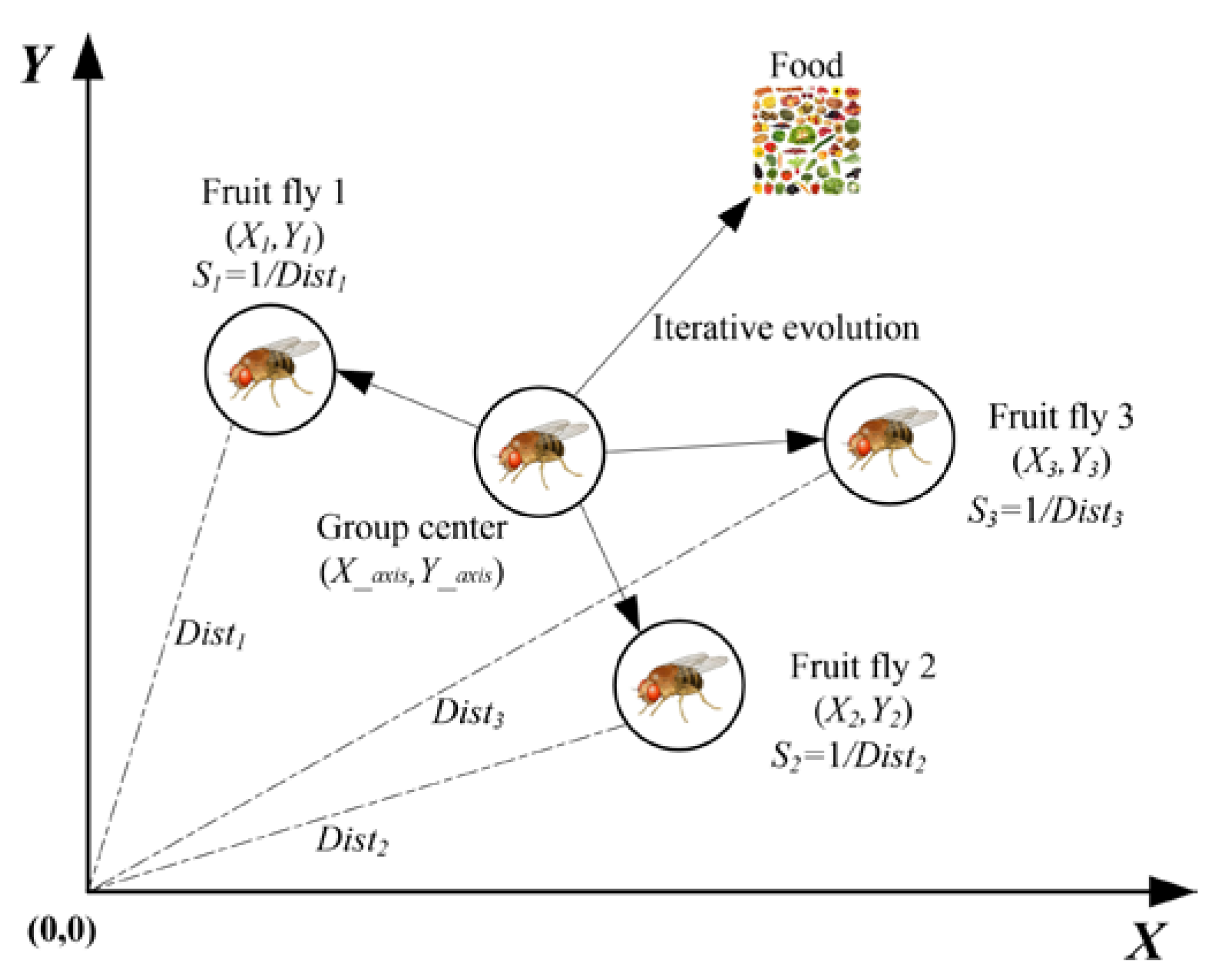
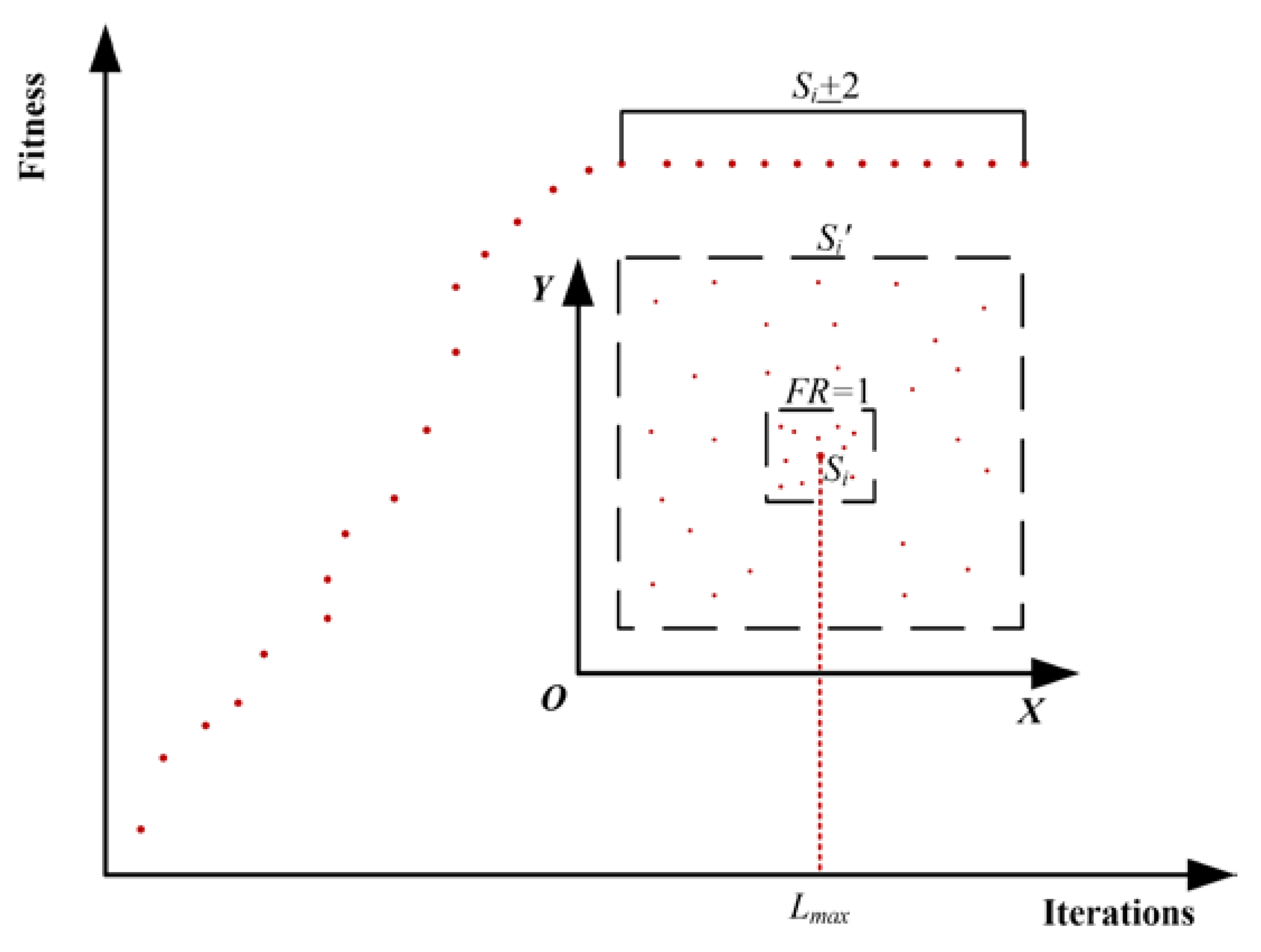
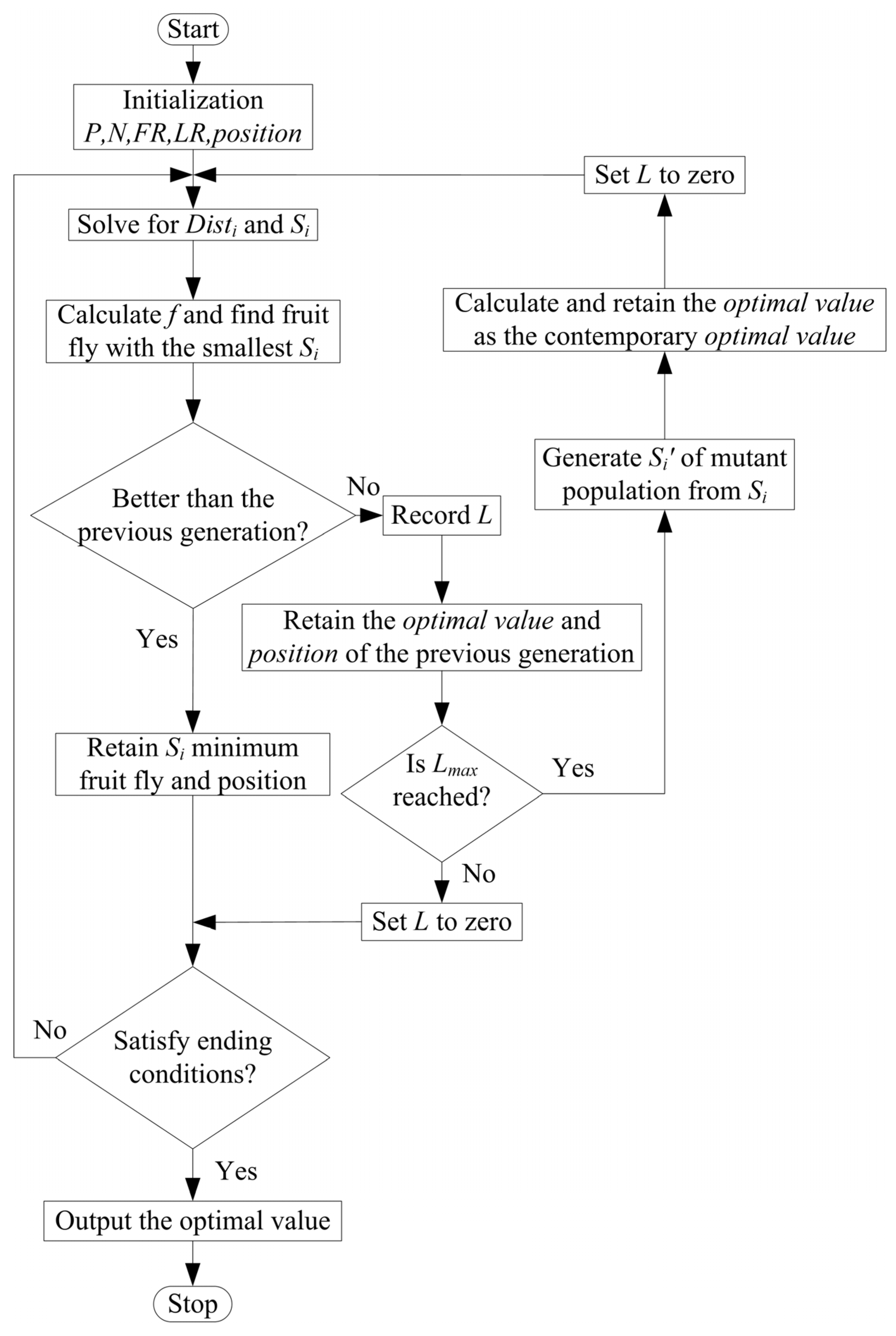
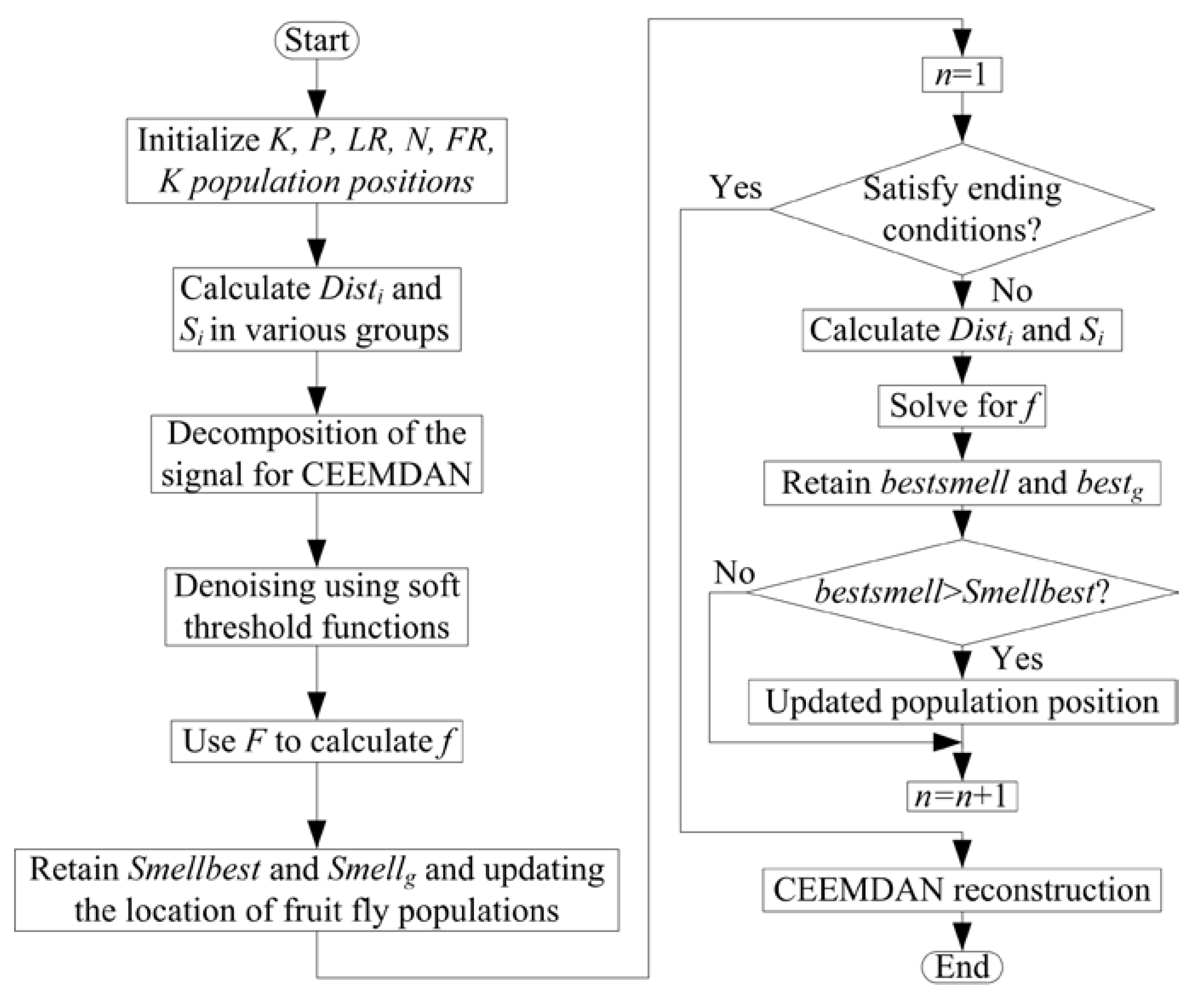
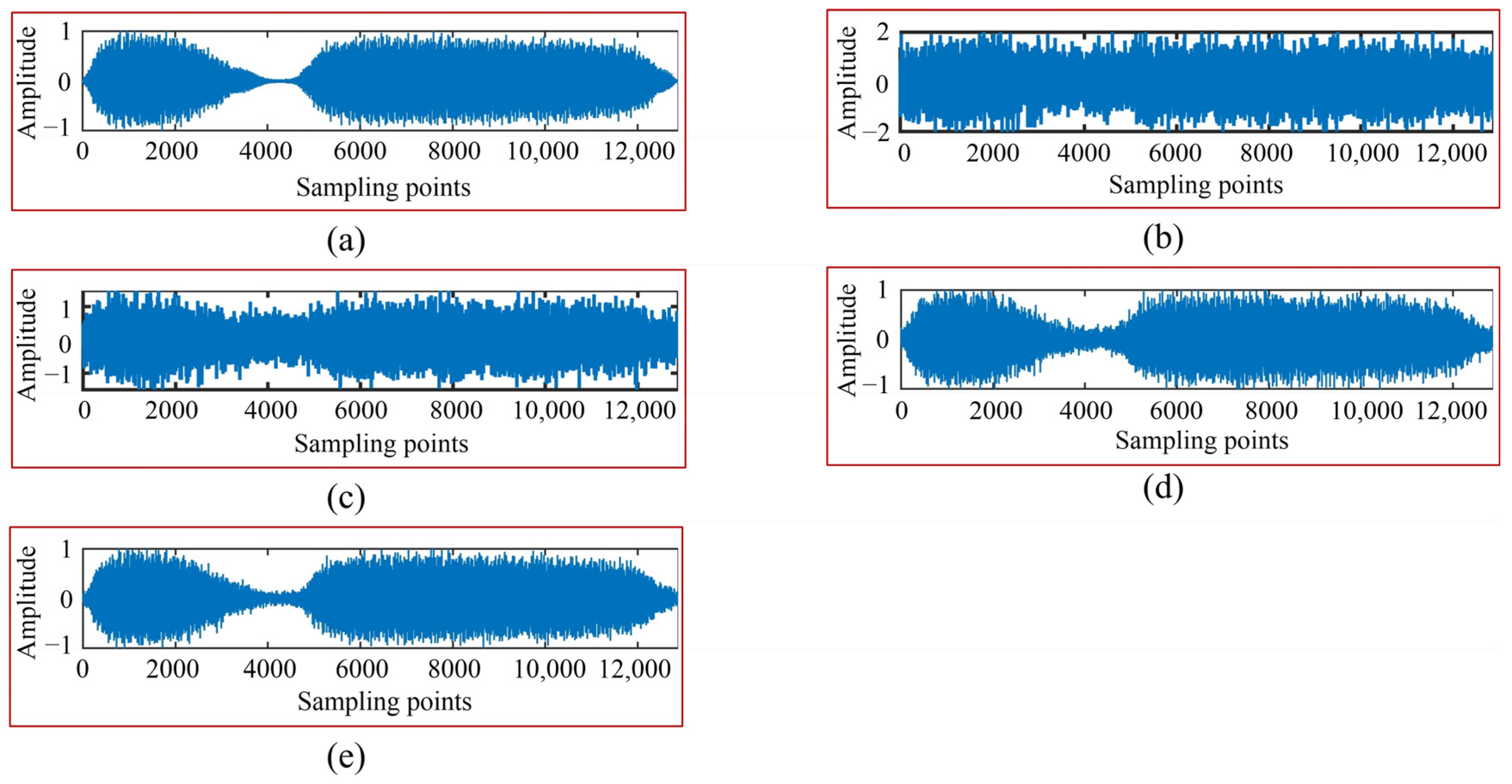
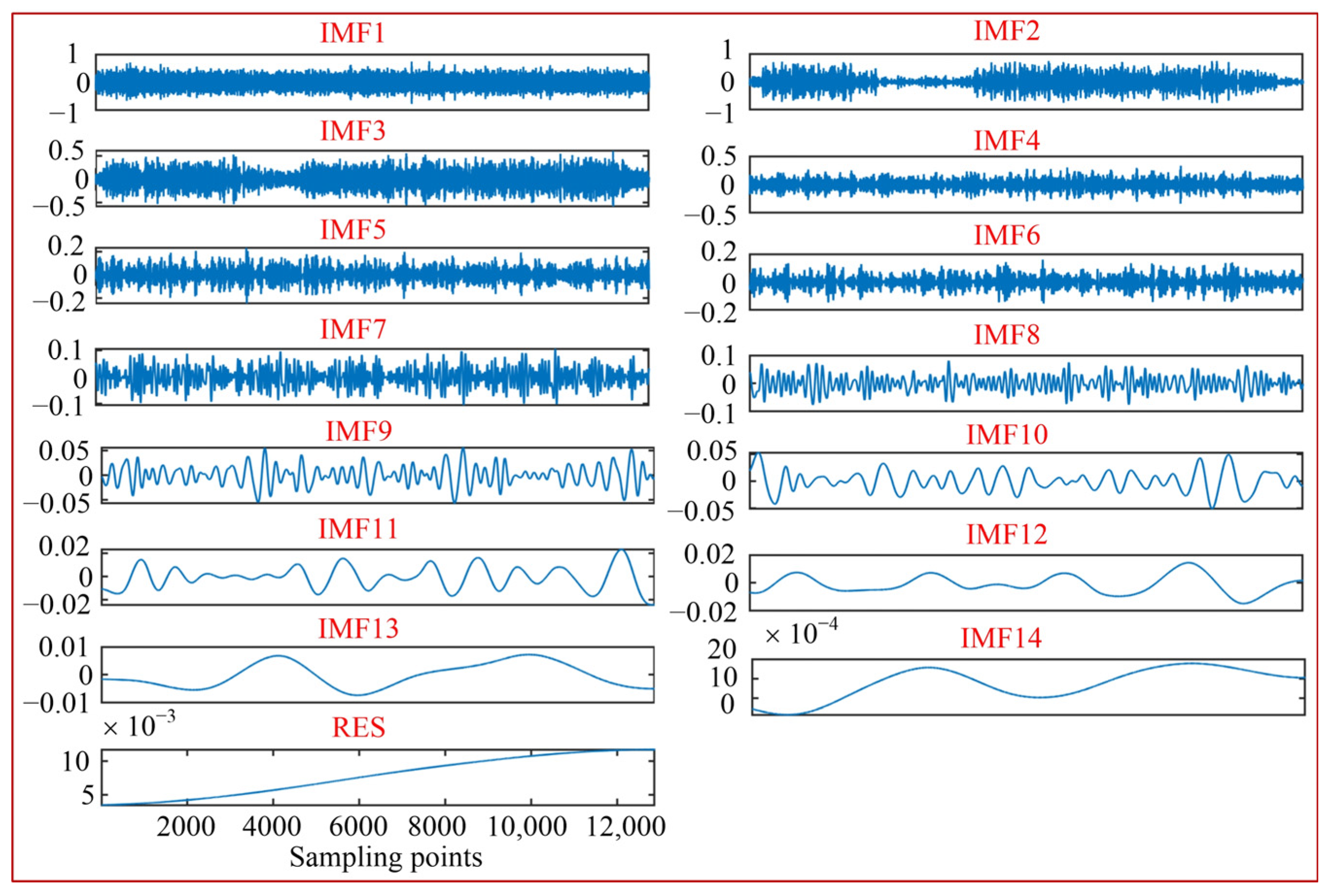




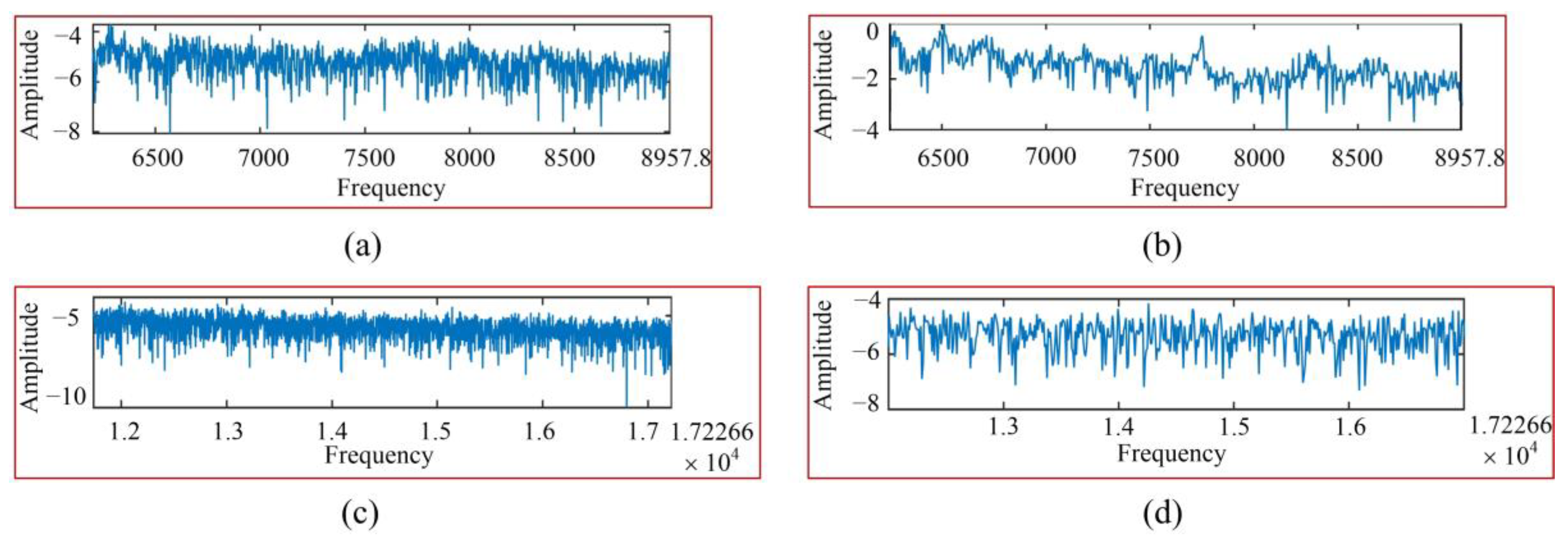
| SNRin/ dB | Evaluation Indicators | EMD Denoising | CEEMDAN Denoising | CEEMDAN-PSO Denoising | CEEMDAN-FOA Denoising | Improved CEEMDAN Denoising |
|---|---|---|---|---|---|---|
| 0 | SNRout | −48.0023 | −46.5517 | −45.1962 | −44.6335 | −44.0268 |
| MSE | 0.7263 | 0.6965 | 0.6720 | 0.5076 | 0.4261 | |
| 10 | SNRout | −46.5269 | −44.3750 | −43.2623 | −42.5764 | −42.0625 |
| MSE | 0.6674 | 0.5823 | 0.5010 | 0.4881 | 0.3823 | |
| 20 | SNRout | −45.1762 | −43.2473 | −42.6886 | −41.3492 | −41.1201 |
| MSE | 0.5543 | 0.4892 | 0.3942 | 0.3118 | 0.3072 | |
| 30 | SNRout | −45.0268 | −43.0642 | −42.5108 | −41.1682 | −41.0623 |
| MSE | 0.5261 | 0.4631 | 0.3752 | 0.3479 | 0.3326 |
Publisher’s Note: MDPI stays neutral with regard to jurisdictional claims in published maps and institutional affiliations. |
© 2022 by the authors. Licensee MDPI, Basel, Switzerland. This article is an open access article distributed under the terms and conditions of the Creative Commons Attribution (CC BY) license (https://creativecommons.org/licenses/by/4.0/).
Share and Cite
Ren, C.; Xu, J.; Xu, J.; Liu, Y.; Sun, N. Coal–Rock Cutting Sound Denoising Based on Complete Ensemble Empirical Mode Decomposition with Adaptive Noise and an improved Fruit Fly Optimization Algorithm. Machines 2022, 10, 412. https://doi.org/10.3390/machines10060412
Ren C, Xu J, Xu J, Liu Y, Sun N. Coal–Rock Cutting Sound Denoising Based on Complete Ensemble Empirical Mode Decomposition with Adaptive Noise and an improved Fruit Fly Optimization Algorithm. Machines. 2022; 10(6):412. https://doi.org/10.3390/machines10060412
Chicago/Turabian StyleRen, Chaofan, Jing Xu, Jie Xu, Yanxin Liu, and Ning Sun. 2022. "Coal–Rock Cutting Sound Denoising Based on Complete Ensemble Empirical Mode Decomposition with Adaptive Noise and an improved Fruit Fly Optimization Algorithm" Machines 10, no. 6: 412. https://doi.org/10.3390/machines10060412
APA StyleRen, C., Xu, J., Xu, J., Liu, Y., & Sun, N. (2022). Coal–Rock Cutting Sound Denoising Based on Complete Ensemble Empirical Mode Decomposition with Adaptive Noise and an improved Fruit Fly Optimization Algorithm. Machines, 10(6), 412. https://doi.org/10.3390/machines10060412





